What 100 years of" improvement " of pedigreed dogs have led to
By Pictolic https://pictolic.com/article/what-100-years-of-improvement-of-pedigreed-dogs-have-led-to.htmlThe age of breeding" improvements " of pure breeds has turned once healthy dogs into deformed animals.
There is an opinion that purebred bred dogs have special qualities and generally look more beautiful. But recently on the Internet there were photos from the book of 1915-W. E. Mason "Breeds Of All Nations" (Breeds Of All Nations by W. E. Mason), which clearly demonstrate how the appearance of all known dog breeds has changed over the past century. It is clear to see how the age-old breeding work to "improve" breeds has had a detrimental effect on the appearance and health of purebred dogs.
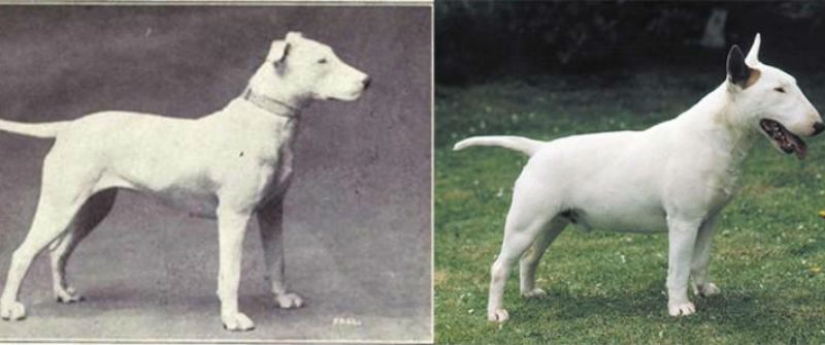
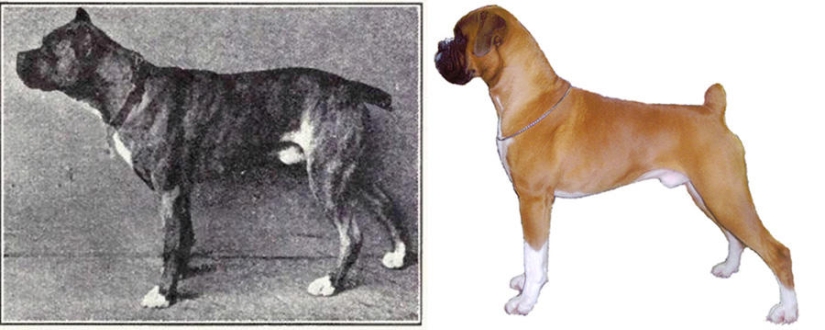
The modern boxer now has even more problems with overheating due to the fact that the muzzle has become even shorter and more upturned than before. Shortening of the muzzle leads to problems with teeth and hearing.
Many puppies are born deaf in one or both ears. Often there is an entropion (inversion of the eyelid). There are several other disorders associated with the preservation of their appearance — aortic stenosis and arrhythmogenic cardiomyopathy of the right ventricle, hypothyroidism and bloating.
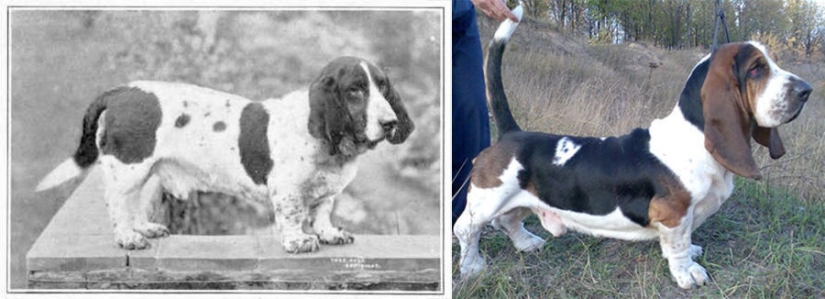
The comparison shows that the basset hound has become much shorter, and its ears are much longer in comparison with the dog in the photo a century ago.
From the reduction of the hind legs, the dog got even more problems with the spine and hip dysplasia. Because of this, the animal quickly gains weight, which only exacerbates its diseases. Permanent eye problems-from glaucoma to ectropia ("cherry eye"). Big ears may look cute, but they're a big nuisance to a dog.
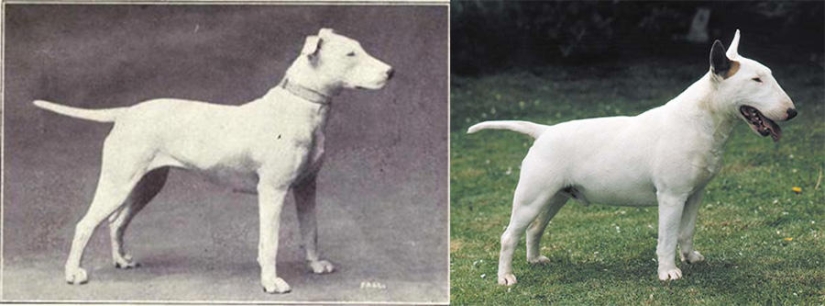
The Bull Terrier was a beautiful athletic dog. Without the ugly muzzle and saggy belly. The new shape of the skull has led to dental problems and progressive deafness. In addition, the dog has a congenital dislocation of the elbow and frequent sunburn.
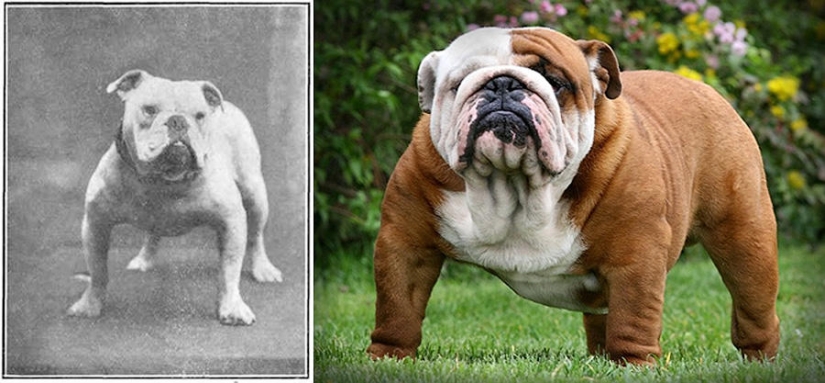
The English bulldog-the star of the Churchill-era safety posters - has turned into a real monster thanks to breeding. Today it is one of the most painful dogs.
In fact, there is no such thing as a healthy bulldog: hip dysplasia, congenital dislocation of the elbow, tracheal hypoplasia, dermatitis of the skin folds, brachycephalic syndrome, entropion… Maintaining the breed made it impossible to give birth without medical intervention. The average life expectancy is only 6.25 years.
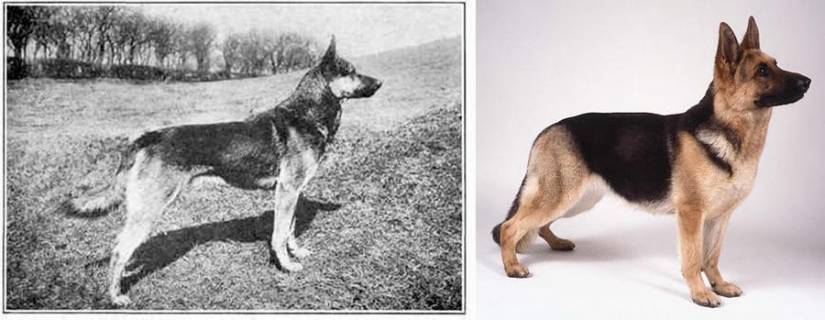
Even the German Shepherd, which was often the standard of a "real" dog, degrades. The book "Breeds of all Nations" describes the standard of 25-30 kg. Today it is a very heavy dog. Hence the problems with the spine and hind legs.
Dysplasia of the elbow and hip joint, disease of the intervertebral discs, lameness. As well as diabetes, cataracts and all kinds of tumors. Once dogs of this breed were able to take barriers with a height of 2.6 meters, but now their croup is lowered, the dog has become angular, and the chest sticks out like a wheel-accordingly, the German Shepherd no longer has such physical indicators.
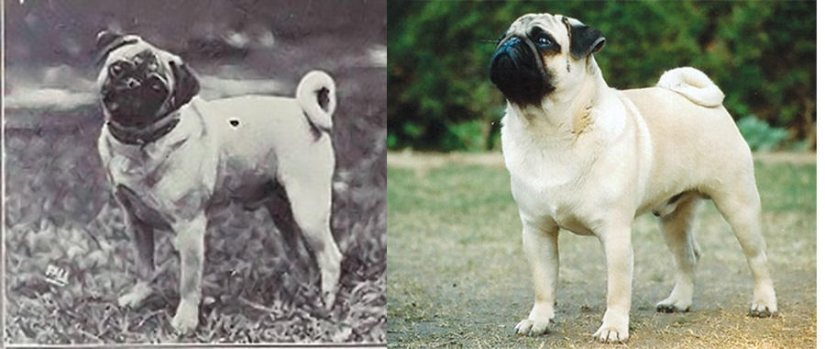
Pugs received a gift from a human tail, which is twice as twisted as before, which, according to Musculus, can lead to paralysis. A shortened muzzle and creased skin often lead to overheating.
Pugs, like all brachycephalians, have huge breathing problems and are predisposed to respiratory diseases. A shortened muzzle always leads to problems with the teeth and infections of the skin fold on the muzzle. They are characterized by obesity. Pug encephalitis is a genetic disease. The symptoms of this disease are seizures, disorientation, blindness, coma, and death. However, pugs can suffer from epilepsy, which is not related to encephalitis.
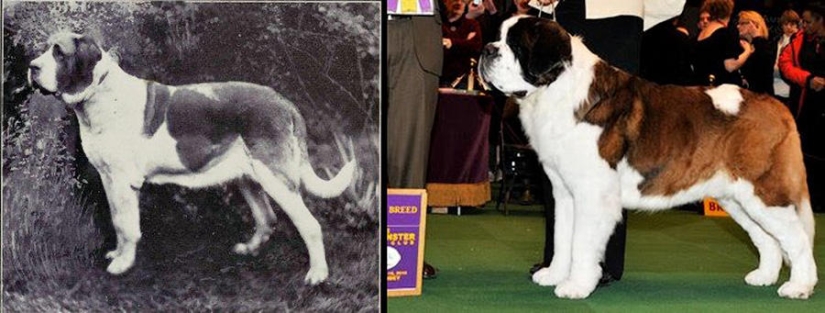
The strongest changes have been made to the St. Bernards: the once downed, athletic breed now has many problems with overheating and is more susceptible to various diseases.
The St. Bernard has put on a lot of weight. The same dysplasia of the elbow and hip joint, dislocation of the kneecap, bloating. Often there is congenital deafness and epilepsy. In addition, the breeders greatly increased his skin. Because of this, dogs quickly overheat. With all the ensuing consequences. And cataracts, "cherry eye", eversion and inversion of the eyelid.

Photos of the dachshund show how much the proportions of the legs and body of the animal are disturbed in comparison with the past, which means a greater risk and susceptibility to diseases of the intervertebral discs. The dachshund has reduced hind legs, which immediately gives problems with the legs and spine. Dachshunds began to gain weight much faster. Problems with the intervertebral discs can make a dog a cripple.
Carolyn Kisko, secretary of the Kennel Club, notes that there are both bad and good examples of breeding breed work. This depends in part on how the work is organized.
Here's what she told a MailOnline reporter:
"Dog breeding is a relatively unregulated industry, and along with every responsible breeder who breeds healthy animals, there are always those who breed dogs for the sake of money and try to strengthen certain characteristics of breeds that are in fashion and in demand. They often ignore the rules regarding the health of dogs in the breed standards, and all other criteria.
There are clear rules and veterinary checks at dog shows — to ensure that unhealthy and hypertrophied dogs do not receive awards. "The breeder's scheme approved by the Kennel Club" (Kennel Club Assured Breeder Scheme) is the only one that correctly sets standards and controls breeders. Outside of this scheme, we cannot control breeders, protect dogs, or guide puppy buyers.
Buyers of puppies should always watch not only the puppy, but also its parents, and avoid those dogs whose parents have any hypertrophied properties — for example, an excessively short muzzle, an excessively wrinkled skin or overweight."
Keywords: Animals | Dogs | History | Then and now | Breeds
Post News ArticleRecent articles

Markus Reugels is an incredibly talented German photographer who specializes in high-speed and macro photography. His photographs ...

Learn unusual and interesting facts about our planet and the creatures that inhabit it! -- >Ants, when dying, emit special ...
Related articles

Learn unusual and interesting facts about our planet and the creatures that inhabit it! -- >Ants, when dying, emit special ...

At the word "harem" most people come up with colorful pictures-an abundance of seductive half-dressed women, gurgling water ...

Many people are afraid of bees, although they are quite peaceful insects if you do not touch them. The worst thing is when there is ...

The Japanese craftswoman has honed her skills in working with wool so much that now her crafts - felted animal figurines - look as ...